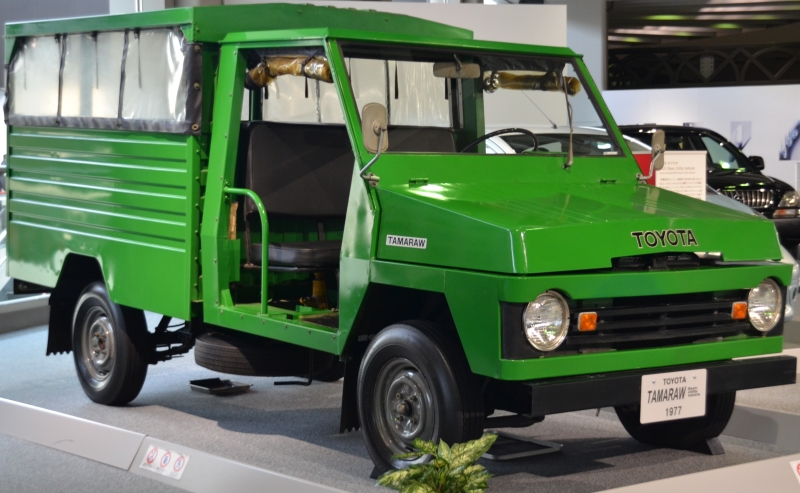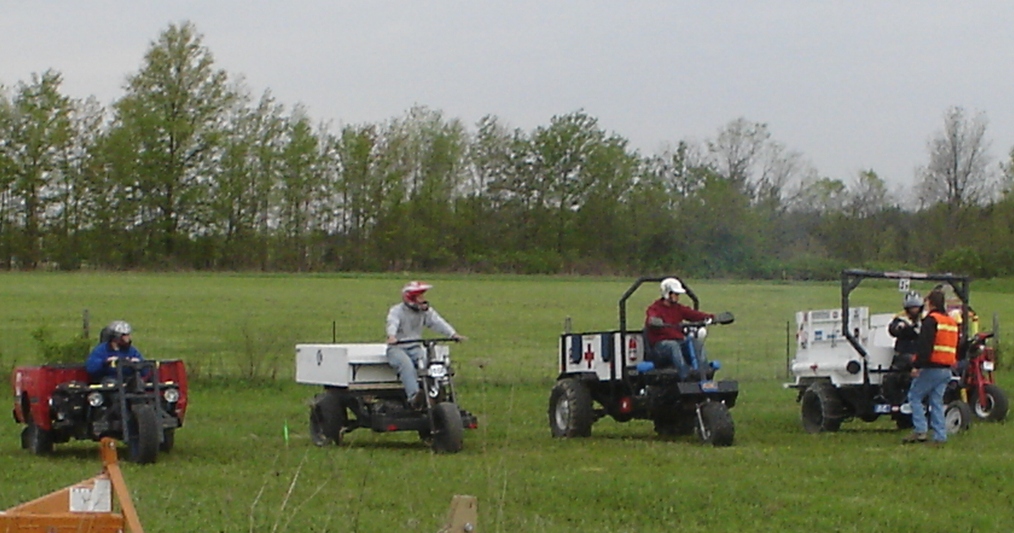Basic Utility Vehicle on:
[Wikipedia]
[Google]
[Amazon]
A Basic Utility Vehicle (BUV) is a simple rugged vehicle designed for use in the developing world. A slew of such vehicles were developed in the late 1960s and early 1970s; most only reached limited production and market penetration as used Western vehicles often proved cheaper. In Southeast Asia, these are often referred to as "AUVs", or "Asian Utility Vehicles". They have also been called "Basic Transportation Vehicles" (BTV).
The acronym has also been used by the
 Greek financier Peter Kondorgouris began producing a small utility vehicle called the Farmobil, based on a 1957 design by Wilfried Fahr of Switzerland. Using BMW engines, about 1000 were built between 1962 and 1966. The Farco company was taken over by Chrysler in the mid-sixties and they took over distribution in many markets.
Greek financier Peter Kondorgouris began producing a small utility vehicle called the Farmobil, based on a 1957 design by Wilfried Fahr of Switzerland. Using BMW engines, about 1000 were built between 1962 and 1966. The Farco company was taken over by Chrysler in the mid-sixties and they took over distribution in many markets.
 Basic utility vehicles were developed by
Basic utility vehicles were developed by 

 The
The
BUV Design Competition official website
Off-road vehicles Sustainable transport
Institute for Affordable Transportation
The Institute for Affordable Transportation (IAT) is a non-profit organization located in Indianapolis, Indiana, USA. The IAT is devoted to developing high-quality, low-cost transportation to provide mobility, freedom and economic hope to people ...
(IAT), who currently holds annual competitions aimed at developing new such vehicles.
1960s
 Greek financier Peter Kondorgouris began producing a small utility vehicle called the Farmobil, based on a 1957 design by Wilfried Fahr of Switzerland. Using BMW engines, about 1000 were built between 1962 and 1966. The Farco company was taken over by Chrysler in the mid-sixties and they took over distribution in many markets.
Greek financier Peter Kondorgouris began producing a small utility vehicle called the Farmobil, based on a 1957 design by Wilfried Fahr of Switzerland. Using BMW engines, about 1000 were built between 1962 and 1966. The Farco company was taken over by Chrysler in the mid-sixties and they took over distribution in many markets.
1970s
 Basic utility vehicles were developed by
Basic utility vehicles were developed by Ford
Ford commonly refers to:
* Ford Motor Company, an automobile manufacturer founded by Henry Ford
* Ford (crossing), a shallow crossing on a river
Ford may also refer to:
Ford Motor Company
* Henry Ford, founder of the Ford Motor Company
* Ford F ...
and GM specifically for sale in East Asia, with the intent of opening new markets there and in Africa. Volkswagen
Volkswagen (),English: , . abbreviated as VW (), is a German Automotive industry, motor vehicle manufacturer headquartered in Wolfsburg, Lower Saxony, Germany. Founded in 1937 by the German Labour Front under the Nazi Party and revived into a ...
also developed a vehicle, the EA489 Basistransporter which was built from 1975 until 1979. Dutch DAF developed a stillborn competitor for this field, the 1972 BATU (Basic Automotive Transport Unit) General Motors' BTV effort was sold under a variety of different names and used the Vauxhall Viva
The Vauxhall Viva is a small family car that was produced by Vauxhall in a succession of three versions between 1963 and 1979. These were designated as the HA, HB and HC series.
The Viva was introduced a year after Vauxhall's fellow GM compa ...
's underpinnings and 1256 cc inline-four engine
A straight-four engine (also called an inline-four) is a four-cylinder piston engine where cylinders are arranged in a line along a common crankshaft.
The vast majority of automotive four-cylinder engines use a straight-four layout (with the ...
. It was built in Ecuador, Malaysia, Costa Rica, Paraguay, Portugal, and the Philippines. It was marketed as the GM Amigo, Andino (Ecuador), Mitaí (Paraguay), and Bedford Harimau ("Tiger", Malaysia).
Citroën
Citroën () is a French automobile brand. The "Automobiles Citroën" manufacturing company was founded in March 1919 by André Citroën. Citroën is owned by Stellantis since 2021 and previously was part of the PSA Group after Peugeot acquired ...
's FAF and Baby Brousse also fit this mold, with the acronym FAF standing for "Easy to Finance, Easy to Build." The FAF and related versions entered production in ten countries, most of them in the developing world. Over 30,000 were built from 1973 until the 1980s. Nissan
, trade name, trading as Nissan Motor Corporation and often shortened to Nissan, is a Japanese multinational corporation, multinational Automotive industry, automobile manufacturer headquartered in Nishi-ku, Yokohama, Japan. The company sells ...
called their Datsun 1200 AX a BTV, it was introduced in June 1977 and received their 1171 cc A12 engine. Nissan/Datsun built it in Thailand (Siam Motors) and in Portugal. In Portugal it was called the Datsun Sado. The most successful BUV is arguably the Toyota Kijang
The Toyota Kijang is a series of pickup trucks, multi purpose vehicles and light commercial vehicles sold mainly in Southeast Asia, Taiwan and India by Toyota. It was first introduced in Indonesia in 1977 and had become the most popular car i ...
, which entered production in Indonesia and the Philippines (as the Tamaraw) in 1977 and 1976. The Kijang/Tamaraw has, over five generations, morphed into a fairly luxurious Compact MPV
Compact MPV (an abbreviation for Compact Multi-Purpose Vehicle) is a vehicle size class for the middle size of MPVs. The Compact MPV size class sits between the mini MPV and large MPV (minivan) size classes.
Compact MPVs remain predominantly a ...
called the Toyota Innova
The Toyota Innova is a car manufactured by the Japanese carmaker Toyota since 2004. It is a multi-purpose vehicle (MPV) or minivan and mainly sold with three-row seating. Its official name in Indonesia is Toyota Kijang Innova, while for other ...
. It even spawned rivals in the Philippine market. Those include the Ford Fiera (later known as Nissan Bida), Isuzu KC 20, Mitsubishi Cimarron, and the GM Harabas (made by General Motors
The General Motors Company (GM) is an American Multinational corporation, multinational Automotive industry, automotive manufacturing company headquartered in Detroit, Michigan, United States. It is the largest automaker in the United States and ...
).
One thing that unites the various Basic Utility Vehicles of this era is that they used almost exclusively flat, welded sheetmetal, giving them a certain uniformity of appearance. Later yet, the independent, wood-bodied Africar
The Africar project set out to provide vehicles able to cope well with the rough terrain of Africa, but also cheap enough to be bought widely in Africa.
Design
They were initially to have Citroën engines and drivetrains, until such time as ...
project again tried to target developing markets, Africa in particular. Only six were built from 1986 until the company folded in 1988.
2000s
With the steady supply of lightly used vehicles from Western markets proving more desirable than the spartan BUVs, the BUV idea largely faded during the 1980s.BUV Design Competition

 The
The Institute for Affordable Transportation
The Institute for Affordable Transportation (IAT) is a non-profit organization located in Indianapolis, Indiana, USA. The IAT is devoted to developing high-quality, low-cost transportation to provide mobility, freedom and economic hope to people ...
(IAT) sponsor an annual BUV Design Competition where engineering students bring their vehicles for judging and performance evaluation (including cost) and contribute to IAT's research and development efforts. This is an effort to develop a simple, low-cost utility vehicle that can benefit low-income people in rural areas of developing countries.
Student teams design and build these vehicles to compete in a series of tests and events to determine the best design. Each team also plans an oral report aimed towards the judges and spectators. In the reports, students discuss the planning, building, and testing processes that each BUV went through prior to the competition. Because the BUV must account for a lack of infrastructure, the vehicles must pass a variety of tests during the competition including an obstacle course, mud pit, mogul field, and endurance track. Many of the students work on the BUV as a senior capstone project at the end of their engineering degree.
BUVs are designed around these specifications:
*Cost: less than $1000
*Payload: 1000 lbs
*Maximum speed: 20 mph
*Weight: 500 lbs.
*Engine: 10 or 11 HP, gasoline or Diesel
*Materials: pickup-truck axle, steel tubing and angle etc.
*Maximize: Number of unassembled kits that fit in 20' ocean container
*Minimize: Total cost of ownership, custom designed parts, part number count
*Excluded Doors, body panels, glass, trim, gauges, hydraulics, radiator, heater
See also
*Institute for Affordable Transportation
The Institute for Affordable Transportation (IAT) is a non-profit organization located in Indianapolis, Indiana, USA. The IAT is devoted to developing high-quality, low-cost transportation to provide mobility, freedom and economic hope to people ...
* Student Design Competition A student design competition is a specific form of a student competition relating to design. Design competitions can be technical or purely aesthetic. The objective of technical competitions is to introduce students to real-world engineering situati ...
* Formula SAE
Formula SAE is a student design competition organized by SAE International (previously known as the Society of Automotive Engineers, SAE). The competition was started in 1980 by the SAE student branch at the University of Texas at Austin after ...
References
{{reflistExternal links
BUV Design Competition official website
Off-road vehicles Sustainable transport